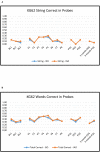Treatment of the Linguistic and Temporal Components of Lexical Activation to Improve Word Retrieval in Aphasia
- PMID: 36188998
- PMCID: PMC9397957
- DOI: 10.3389/fresc.2022.824684
Treatment of the Linguistic and Temporal Components of Lexical Activation to Improve Word Retrieval in Aphasia
Abstract
Current approaches to treatments for word processing impairments in aphasia emphasize two components to target, the linguistic content, semantic or phonological representations of words, and the processing component, access to and retrieval of those representations. In this study, we explore these two components of a treatment to improve lexical activation that supports access and retrieval of word representations. Five people with aphasia participated. The treatment task was repetition of concrete word pairs after a 5-s response delay which was intended to provide practice in maintaining activation of the words for that 5-s period before reproducing them. Two of the five participants demonstrated a difficulty in maintaining activation of single words in repetition, with accuracy decreasing significantly after the 5-s interval. The treatment was applied to all participants, however, to determine if its benefit was specific to those with the activation maintenance impairment. Results confirmed that the activation maintenance treatment in the context of this repetition task led to more treatment gains for the two participants who demonstrated this specific impairment. They made gains on four of the nine measures compared to improvements on one to two measures for the other participants. A second question addressed in this study was the relative importance of the item component (linguistic content) of the treatment and the processing component, maintenance of activation. To that end, there were two conditions of treatment probes, (1) repeated content for all treatment, immediate post-treatment and 3-month maintenance probes and (2) novel content for probes in these three phases of treatment. Only one participant showed significant improvement in treatment when items were novel for all probes. We discuss the possibility that this outcome reflects a more specific deficit in the temporal processing component of lexical activation compared to the two other participants who showed better performance on probes with repeated items in treatment and post-treatment phases. Clinical implications of this study and directions of future research are discussed.
Keywords: aphasia treatment; impaired lexical activation; temporal processing of words; verbal short-term memory; word processing treatment.
Copyright © 2022 Martin, Obermeyer, Schlesinger and Wiley.
Conflict of interest statement
The authors declare that the research was conducted in the absence of any commercial or financial relationships that could be construed as a potential conflict of interest.
Figures






References
-
- Foygel D, Dell GS. Models of impaired lexical access in speech production. J Mem Lang. (2000) 43:182–216. 10.1006/jmla.2000.2716 - DOI
Grants and funding
LinkOut - more resources
Full Text Sources

